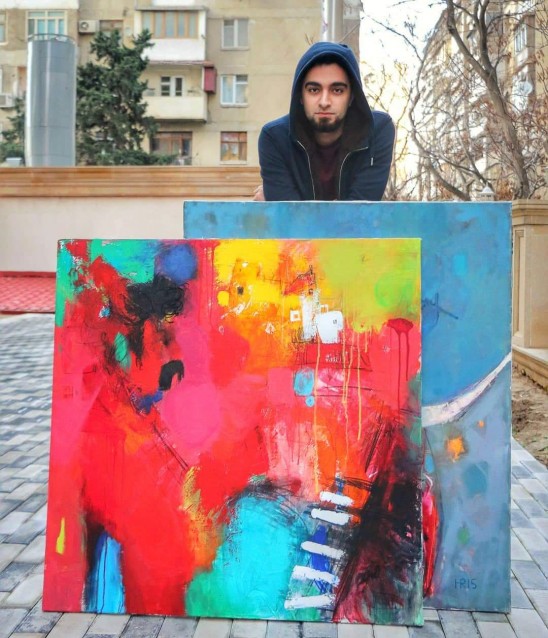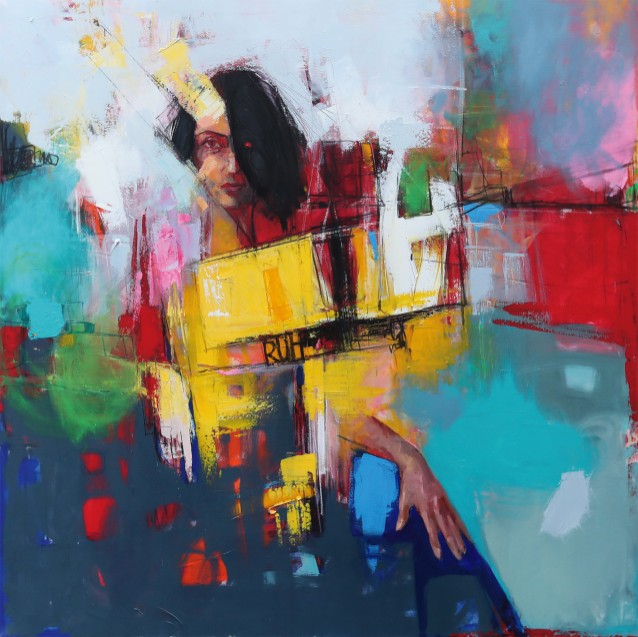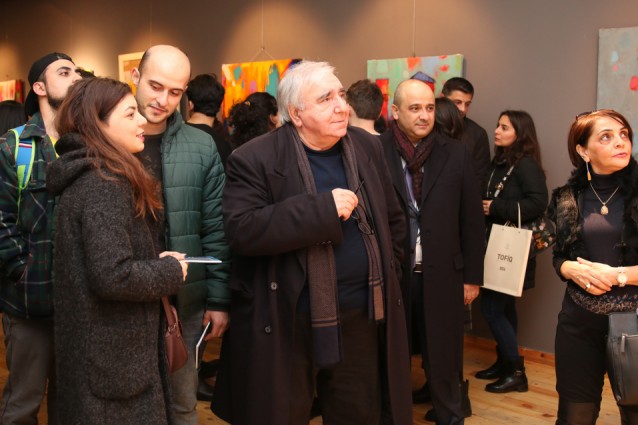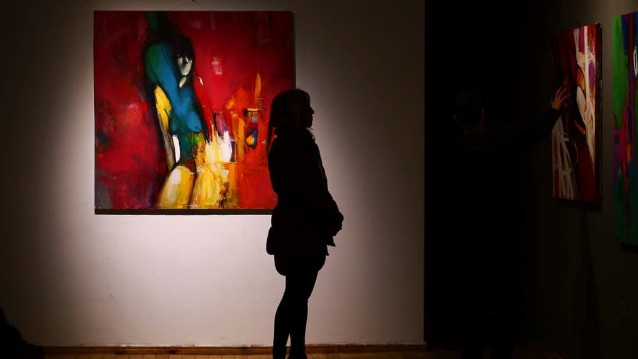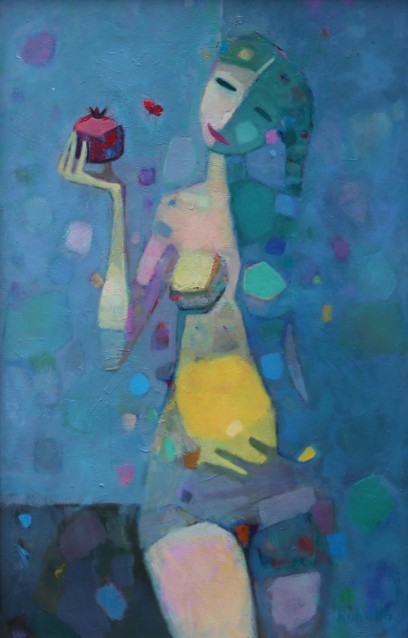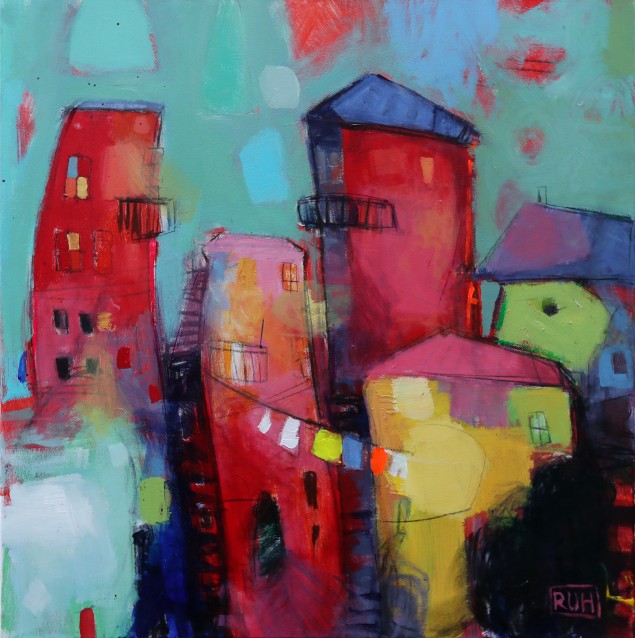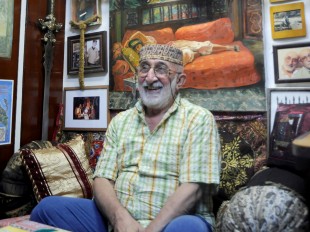Eagerly anticipated, the opening of RUH (ruh is an Azerbaijani word expressing spirit, soul, inner being, emotion, perception, core) Ruhulla Hasanzade’s first senior solo exhibition, on 17 December 2018 was a-buzz with an encouragingly youthful turnout enthusiastic about both art and artist. As he explained later, the semi-eponymous title of the showing embodied his mission to give the soul freedom, and ‘spirited’ is a fair description of the occasion at Icherisheher’s Center of Contemporary Art.
Once at the exhibition, it was heartening to hear opening words from senior members of Azerbaijan’s art world, the artists Arif Aziz and Arif Huseynov and critic Ziyadkhan Aliyev, as well as sculptor and proud father Ibrahim Hasanov – this was a present for him on his 65th birthday.
Arif Aziz:
Not everyone feels ‘ruh,’ but I feel it in Ruhulla’s paintings. The colours in his compositions are delightful... There are many good artists in the younger generation, and Ruhulla has made his own mark among them.
His works are very modern and are not only for Azerbaijan, they could well be shown abroad. They would please a foreign public.
Arif Huseynov:
He’s an artist of his young generation...always searching for something in his works... I’ve discovered for myself an artist of the 21st century.
Not many artists can show their love for art with such independence... He’s a thinking artist... when you see that kind of artist’s work, you sense that he knows his work.
There was also a corner dedicated to his book illustrations, but for the fullest expression of the Hasanzade spirit we naturally focused, as much as we could through the throng, on the paintings. For all his versatility, these are the clearest expressions of the artist’s ruh and, impressed, we were keen to get some background.
Meeting up with Ruhulla a few days later in a favourite haunt close to the bustle of the New Year Fair in Fountains Square, we were keen to hear his reflections on the exhibition and its reception. It soon became apparent that even in the midst of the hustle, his antennae were fully operational in the observation necessary to all art. Appreciating the support of those who engaged with his art, he recognised that there were others who were there just for the occasion, or to be seen:
...everything effects, even the downside of life, but I try to get the positive out of all that and put it into my work, baring my soul.
The road to ruh
With a sculptor father, it’s no surprise to learn that these talents for art and observation were developed from an early age, nor that they pushed against the rigidities of school life. It soon became clear as we talked about his quarter century evolution that he’s long been one to colour his own way through life. Having to sit quietly through 45-minute lessons in class seemed unrelated to life outside, as did uniformity of appearance. However, his skills made him popular with classmates in art lessons and with teachers for his decorative contributions to school occasions and performances and he disarmingly describes using this popularity in the cause of certain freedoms.
When the time came to make serious decisions about his future direction, his mother yielded her early ambition for him to follow her into medicine and is now “our strongest critic,” determined to keep Ruhulla and father on their artistic toes. In contrast to school, his time at the State Academy of Arts was,
...very interesting. I loved and fought. I lived all the emotions. When you’re young, your brain is boiling...
Again there are hints of popularity derived from his skills and willingness to share his talents. Anyone following him on the various social networks online is soon aware of his energy and prolific drive to create.
This is particularly evident to those who have worked with him during his three years as illustrator at TEAS Press, where it became something of a tradition to mark special occasions for co-workers by capturing them in caricature. However, the serious business of observation and search for style while maintaining and developing his practical artistic skills is by no means neglected. Asked about the contrastingly more classical form of his pencil sketches and life studies, he explains:
Sketches are mainly practice, not to let my hand forget. When I work in abstract and different styles, I also do classical drawings, portraits and landscapes. Many people can’t take the abstract and they forget that you’re a good or bad artist. That’s why I go back to the classical to show them I can do it.
And here we sense a belief in the basic skills being essential to his concept of artistic integrity, even when much of the output may verge on the abstract.
Art, edge and energy
Perhaps an expert art critic could have predicted it, but even in retrospect, the first name Ruhulla mentions when asked about favourite artists is a fit, and is credited as matchmaker in his romance with the colour yellow. The name was Vincent Van Gogh – and not only for his colour and expression, which may have been helped by not having too much of the “study that can kill”... The Dutch artist’s persistence, honesty and need to work in the face of eventually overwhelming adversity, also provide inspiration. As well as Ibrahim Hasanov, contemporary northern artists Gitte Citrup and Lars Kristian Hansen are also appreciated.
At one point in the discussion roles were reversed with Ruhulla asking for our views on the paintings – he explained that the creative flow is not always continuous and criticism can help fire his way forward:
Before the exhibition I had a crisis; I was stuck. And some special people’s reactions to my work helped me out. Like being stuck in the middle of the forest and someone calls you, you follow the voice and find the way out.
As with his observations on those who attended the opening, there can be an edge to his art, especially in his portraits (the self-conscious pose in Qürur – Pride; the sombre apprehension slashed by the red of Günah – Guilt), but there is plenty of love and affection too – for the beauty of woman (the fertility of love in Hamilə Qadın – Pregnant Woman) or the transcendence of revered kamancha player Habil Əliyev. And also for his home town; even his most abstract Baku cityscapes are humanised by warmth of colour and dabs of wit – hints of washing line or rickety old courtyard staircase are focal points as touching as the Vaqif moustache that hit us in the Mugham Centre. His hot Günorta (Midday) city is cooled delightfully by its mingling population of white birds.
Ruhulla’s restless energy and output clearly arise from an urgent need to express, but an exhibition also raises the question of the use and effect of art in society. Catharsis, he says, continuing:
Maybe the way to God is through art. There are three ways of living: physically, by the soul and with the brain. Not many people can live by the soul, they forget about it, don’t ask what the soul wants... We come from God and go back to God, on the way we become closer to God. If I don’t think I’m God I can’t create anything... In saying God I am not thinking about religion, it can be what you believe in, it may be energy... Art makes you sensitive, you feel more sharply.
Attempting to squeeze the genie of an artist’s work into a bottle of printed word is a pretty thankless task – as with all arts nothing connects so well as being in the living presence. For a glimpse at more of his works, go to http://www.ruhart.studio/ paintings ... but we expect that further exhibitions will give more people the chance to ponder at first hand the skill, energy and the spirit of Ruhulla Hasanzade.
About the authors: Ian Peart is a writer, editor and former editor of Visions. Narmin Babayeva is a freelance translator and editor. Both are former col- leagues of Ruhulla Hasanzade.
